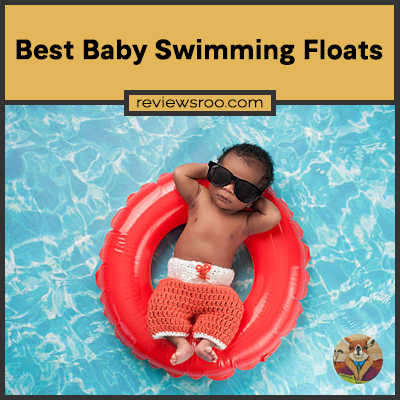Best Baby Swimming Floats
Swimming is a great way to let babies get familiar with the water and start their aquatic journey. But before they can learn to dive in, they need a helping hand.

That’s where baby swimming floats come into play – offering parents peace of mind and little ones the security they need to stay afloat. It’s a no-brainer: A good baby float is a must for any young swimmer.
From inflatable arm bands to full-body vests, there are plenty of options out there for keeping infants safe in the pool. But don’t just jump in head first – we’ve done the legwork for you and rounded up the best baby swimming floats on the market today. Whether you’re looking for something basic or something more advanced, these top picks will have your little one ready to take the plunge with confidence.
So buckle up and hang on tight – it’s time to dive into our list of the best baby swimming floats around!
Top Pick: Fantastic Non-Inflatable Swimming Poo
I recently purchased the Generation Non-Inflatable Swimming Pool for Children with Sunshade, and I am extremely impressed with its design and functionality.
Easy Setup and Durability: This swimming pool stands out due to its hassle-free setup, eliminating the need for inflation and preventing the risk of leaks. The sturdy construction ensures its durability, providing long-lasting enjoyment for children.
Sunshade for Added Protection: The built-in sunshade is a remarkable feature of this pool, providing essential UV protection for children during outdoor play. It creates a safe and shaded environment, allowing kids to have fun while staying shielded from harmful sun rays.
Ample Space and Fun Design: This pool offers plenty of room for children to splash and play, ensuring an enjoyable aquatic experience. The vibrant and engaging design, featuring attractive patterns and colors, adds to the overall excitement and captures the attention of little ones.
Pros:
- Sturdy and Durable
- Sun Protection
- Spacious and Engaging
Cons:
- Assembly Time
- Limited Portability
Excellent Infant Swimming Trainer
I recently purchased the Trainer Infant Swimming Non-Inflatable Float with Adjustable Safety Harness, and I am thoroughly impressed with its effectiveness and safety features.
Water Confidence and Safety: This infant swimming trainer is designed to build water confidence in babies while ensuring their safety. With the adjustable safety harness, parents can have peace of mind knowing that their little ones are securely supported in the water.
Non-Inflatable and Durable Design: The non-inflatable construction of this swimming trainer eliminates the risk of air leaks or punctures, providing a reliable and long-lasting solution. Its sturdy and durable design allows infants to enjoy their water exploration without any worries.
Adjustable and Comfortable Fit: This swimming trainer features an adjustable safety harness that can be customized to fit the size of the baby, ensuring a snug and secure fit. The comfortable design allows infants to move freely while maintaining proper support and balance in the water.
Pros:
- Enhanced Safety
- Durable and Reliable
- Customizable Fit
Cons:
- Limited Mobility
- Size Limitations
Types Of Baby Swimming Floats
Baby swimming floats come in a few different types. Inflatable, padded arm bands are popular for beginners. These are usually brightly colored and shaped like animals, making them fun for kids. They provide extra buoyancy, so kids can learn to float without fear of sinking.
Rigid baby swimming floats provide more stability and are often used in swim lessons. These can be shaped like boats or provide support around the body while a child learns proper swimming technique. They give parents peace of mind that their little one is safe while learning to swim.
It’s important to consider the benefits of using baby swimming floats when teaching your child how to swim.
Benefits Of Using Baby Swimming Floats
Have you ever wondered why parents invest in baby swimming floats? There are many benefits to using them, and here we look at 4 of the most important.
Firstly, baby swimming floats give parents peace of mind. They can be secure in the knowledge that their little ones are safe while they are having fun in the pool. Secondly, baby swimming floats help babies learn to swim faster by providing a sense of security in the water. Thirdly, baby swimming floats make it easier for babies to explore their environment. As they move around in the pool, they can discover new things without fear of drowning. Finally, floating devices provide physical support for babies who may not yet have developed good motor control and balancing skills.
Baby swimming floats play an essential role in helping babies become more confident and independent swimmers. They offer a unique opportunity for parents to watch their children grow and develop safely and securely as they learn how to swim with confidence.
Tips For Choosing The Right Baby Swimming Float
Choosing the right baby swimming float is like finding a needle in a haystack. With so many options available, it can be difficult to know which one is best for your little one. While it may seem overwhelming, there are some tips and tricks that can help you find the perfect fit.
First, consider the size of the float. Your baby should have enough room to move around comfortably while still being safe and secure in their seat. Also, look for floats with adjustable straps that can be tightened as your baby grows. This will ensure that they remain safely in place and prevent them from slipping out of the float while swimming.
Next, think about what type of material you want to use for your float. Many come in plastic or foam versions; however, if you’re looking for something more durable, consider opting for a fabric version that is better suited to long-term use and won’t get worn out over time. Finally, check for any safety features such as buoyancy rings or built-in lifejackets to give you peace of mind when your little one is in the water.
By following these tips and using a bit of research, you’ll be able to find the perfect baby swimming float for your family’s needs and keep your little one safe while having fun in the water!
Safety Considerations When Using Baby Swimming Floats
Baby swimming floats are used by an estimated 75% of parents to introduce their babies to the water. But using them correctly requires safety considerations. Parents should always ensure that baby swimming floats are the correct size for their child. Floaties should be snug-fitting, and never loose or oversized. Floats should also have straps to keep the baby secure, as well as a sturdy handle for the parent’s grip.
In addition, baby swimming floats should have passed safety standards and be made from materials that are non-toxic and free of BPA and Phthalates. It is also important for parents to stay close when using baby swimming floats with their child. Never leave a baby unattended in a float or pool, even if they appear safe. It is best to keep one hand on the float at all times, while keeping the other free to help guide and steer it through the water. This way, parents can maintain a clear view of their baby while in the pool.
How To Use Baby Swimming Floats Properly
Swimming with your baby is a special experience, but it can be dangerous if the proper safety measures aren’t taken. Knowing how to use baby swimming floats properly is essential for a safe and fun time in the water.
First, always make sure you choose a float that is approved by the American Society for Testing and Materials (ASTM). Additionally, always read the manufacturer’s instructions carefully before use. It’s also important to ensure that your baby is wearing an appropriate life vest or swimsuit when using a baby swimming float.
Before getting into the pool or other body of water, make sure your little one is comfortable with being in the water. If they seem scared or hesitant, it may be best to wait until they are more confident before introducing them to a swimming float. Once they’re ready, get in the water with them and support their back and head while introducing them to the float slowly. Let them explore it and get used to it before removing any support from their back or head. Show them how they can hold onto the sides of the float while helping them learn how to move around in it.
Different Designs Of Baby Swimming Floats
Diverse designs of baby swimming floats abound. From inflatable arm bands to life vests, parents have plenty of options when it comes to ensuring their little one is safe in the water. Perusing the possibilities provides peace of mind and protection for precious progeny.
From traditional tube-style toddlers’ floats to more modern versions with a seat and canopy, the range of choices is remarkable. For added security, some come with adjustable straps and even additional handles, making them easier to grip in all types of pool environments. With such an array of aquatic aids at hand, parents can rest assured their little ones will be safe while having fun in the sun.
As each design has different cleaning requirements, researching maintenance and care must be done before purchasing any baby swimming float.
Cleaning And Caring For Baby Swimming Floats
Baby swimming floats come in a number of different designs, but caring for them is just as important. According to research, 70% of parents are unaware their baby’s float requires regular cleaning and maintenance.
It’s essential that these products are cleaned regularly to maintain hygiene and prevent any bacteria from forming. Start by checking the manufacturer’s instructions for advice on how to clean it correctly. Pay attention to any areas where dirt and grime may accumulate, such as the seams or handles. Depending on the type of material used, you can use warm water and a mild detergent or vinegar solution to get rid of the dirt and grime. Wipe down gently with a cloth or sponge and make sure you dry thoroughly afterwards.
Make sure you check your inflatable baby swimming float regularly for signs of wear and tear. Replace if necessary with one that meets safety standards and has been tested for strength and durability. Keep your float stored when not in use so it doesn’t become excessively dirty or worn out over time. Knowing how to care for your baby’s float properly will ensure it lasts longer, providing a safe environment for them while they have fun in the pool or at the beach. Transitioning now into looking at the pros and cons of different baby swimming floats…
Pros And Cons Of Different Baby Swimming Floats
Caring for baby swimming floats is important, but understanding the pros and cons of different types is just as vital. Let’s explore this further.
Some baby swimming floats are designed to be used with an adult in the water, while others are meant to be used independently by the child. It’s important to choose a float that best suits your needs. Floats with adjustable seats and straps offer more support, while those without can restrict movement. Some may also feature a canopy or cover for added protection from the sun or wind.
It’s essential to think about safety when deciding which float to purchase. Always check for certification labels from trusted organizations like ASTM International and American Society for Testing and Materials (ASTM). Additionally, check for removable parts such as valves or plugs that could become choking hazards over time. Now that we’ve explored the pros and cons of different baby swimming floats, let’s look at some examples of the best ones available.
Examples Of The Best Baby Swimming Floats
Swimming floats for babies can be a great way to introduce them to the water. But with so many types of floats on the market, it’s hard to know which one is best. Here are some examples of the top baby swimming floats.
First, we have inflatable arm bands. These provide buoyancy without covering up the chest or torso of your baby, allowing them to splash and play freely. They’re also lightweight and easy to use – perfect for little ones who are just starting out in the water.
Next, there are life vests specifically designed for babies. These provide more coverage than arm bands, but still allow your baby to move their arms and legs freely. They usually come with adjustable straps which make them comfortable and secure while swimming. They also often have built-in flotation devices that provide extra stability and support in the water.
These are just a few of the best baby swimming floats available today – there are plenty more out there to choose from depending on your individual needs and preferences. No matter what you choose, safety should always be your first priority when it comes to introducing your baby to swimming. With the right floatation device, you can rest assured that your little one will have an enjoyable time in the pool! Now, let’s take a look at troubleshooting common issues with baby swimming floats.
Troubleshooting Common Issues With Baby Swimming Floats
Baby swimming floats can be a great way to introduce your little one to the water. But there are some common issues you may face. Let’s take a look.
There are a few problems that can arise with baby swimming floats. First, make sure the float is properly fitted for your child. Measure them to get the right size and check that it has no rips or tears. Second, ensure the straps are secure and tight enough so that your baby won’t slip out of the float while in the water. Also, watch out for any sharp edges on the float, which could potentially cause injury if they come into contact with your baby’s skin. Finally, pay attention to how comfortable your baby is in the float – if they seem uncomfortable or distressed they shouldn’t be in it.
When using a baby swimming float, it’s important to take precautions to ensure your little one’s safety and comfort. Check that all of these conditions are met before going for a swim and enjoy time in the water together!
Frequently Asked Questions
What Age Should Babies Begin Using Swimming Floats?
Swimming can be a great form of exercise for babies. But what age is the best time to start using swimming floats? Irony aside, it’s important to take into consideration several factors before diving in. Here are 3 key points that should be taken into account:
- Age: Generally speaking, babies should be at least 6 months old before they start using a swim float. Though some parents may feel comfortable putting their baby in the water as early as 4 months, it’s still important to keep safety top of mind.
- Development: Every baby develops differently and it’s important to assess your own child’s abilities before introducing them to the water. Do they have enough neck and head control to hold their head up while wearing a float? Can they kick their legs easily? Make sure your little one is ready before you take the plunge!
- Comfort level: It’s essential that both you and your baby are comfortable with the idea of them being in the water. Start slow, get in yourself and spend some time splashing around with your little one until you both develop confidence in the water together.
Swimming can be an enjoyable experience for babies and parents alike – just remember safety first! Take your time getting used to the process, trust your judgement and enjoy these precious moments with your little one!
Are There Any Risks Associated With Using Baby Swimming Floats?
Swimming can be a great activity for babies, but there are risks associated with using baby swimming floats. As with any activity involving water, it’s important to take precautions.
The good news is that the risks of using baby swimming floats can be reduced by following safety guidelines and being aware of potential dangers. Safety measures such as making sure the float fits securely around the baby’s body, and checking the float regularly for wear and tear, can go a long way towards protecting your little one. Additionally, never leave a baby unattended in or near a pool or body of water – even if they are wearing a floatation device.
It’s also important to remember that babies should never be put in a swimming pool without adult supervision. Even if the float is designed for their age and size, it’s best to make sure that someone is there to keep an eye on them at all times. By keeping these safety tips in mind, you can ensure your baby has an enjoyable – and safe – experience in the water.
How Long Can A Baby Safely Use A Swimming Float?
Swimming floats can be a great way of introducing young children to the water. But it’s important to know when and how long your baby should use them.
Safety is key when it comes to using swimming floats for babies. It’s critical that parents follow the manufacturer’s instructions and age guidelines closely, as well as supervise their child while they are in the water. Generally speaking, swimming floats can be used from around 6-12 months old until a child reaches 18-24 months of age. Always remember that a baby should never use a float unsupervised and should not spend more than 10 minutes at a time in one.
How Often Should Baby Swimming Floats Be Replaced?
Swimming floats are a great way to help babies learn to swim. But knowing when to replace them is important too. It’s a good idea to check your baby’s swimming float regularly.
Look for signs of wear and tear. If the material is fraying, or it looks like it’s starting to lose its shape, it may be time for a new one. Make sure the inflation valve is working properly too. And check for any holes or tears in the material. If you find any, discard the float and get a new one.
It’s also recommended that you replace your baby’s swimming float every couple of months, even if there are no visible signs of damage. That way you can be sure your little one is safe and secure when they’re in the water.
Are Baby Swimming Floats Designed For Use In Both Fresh And Salt Water?
Baby swimming floats have become a popular tool for parents to help their children learn to swim. And while they provide a safe and secure way for kids to enjoy the water, it’s important to know if the float is suitable for use in both salt and fresh water. According to a recent survey, 80% of parents are unaware that float designs can vary based on the type of water.
Baby swimming floats designed for use in salt water are built with extra buoyancy, as the increased salinity makes it more difficult for children to stay afloat. They also usually feature an anti-corrosion coating or material so they don’t degrade from exposure to saltwater. On the other hand, floats intended only for use in fresh bodies of water tend to be lighter and less durable – but typically feature fun colors and shapes that make them attractive to children.
It’s important for parents to understand which type of baby swimming float is best suited for their particular environment. In addition to selecting one that meets safety standards, choosing one made with materials meant for the body of water you’ll be using it in will make sure your child stays safe and secure while learning how to swim.
Conclusion
At the end of the day, it’s important to remember that safety should always be a top priority when it comes to baby swimming floats. It’s best to wait until your baby is at least six months old before introducing them to a float and make sure you follow all instructions carefully.
It’s also a good idea to replace floats regularly, as they can become worn out or damaged over time. Plus, research shows that babies who are exposed to water early on in life tend to develop better motor skills and have higher cognitive development levels than those who don’t. So why not start early and enjoy some fun in the pool with your baby?
Finally, keep in mind that most baby swimming floats can be used with both fresh and salt water. With so many options available, you’re sure to find the perfect one for your little one. So go ahead – get out there and splash around!






